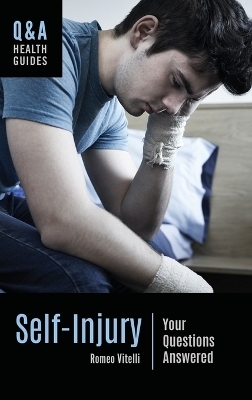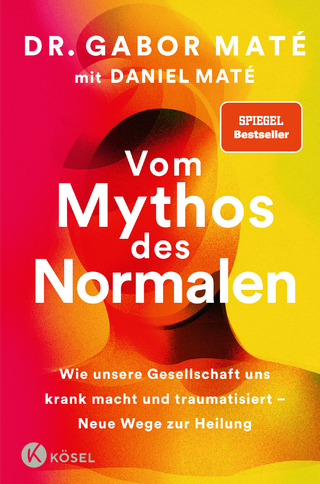
Self-Injury
Greenwood Press (Verlag)
978-1-4408-5444-6 (ISBN)
Regardless of the form it takes, self-injury can leave lasting physical and emotional scars on both those who harm themselves and their friends and family. Part of Greenwood's Q&A Health Guides series, Self-Injury: Your Questions Answered provides clear, concise information for readers interested in or struggling with this often-misunderstood subject. It explores the causes and consequences of self-injury, treatment options that make use of therapy and medication, and the role that popular culture and the media have in shaping our understanding of these behaviors.
Each book in this series follows a reader-friendly question-and-answer format that anticipates readers' needs and concerns. Prevalent myths and misconceptions are identified and dispelled, and a collection of case studies illustrates key concepts and issues through relatable stories and insightful recommendations. The book also includes a section on health literacy, equipping teens and young adults with practical tools and strategies for finding, evaluating, and using credible sources of health information both on and off the Internet—important skills that contribute to a lifetime of healthy decision-making.
Romeo Vitelli received his doctorate in Psychology from York University in Toronto, Ontario, in 1987 and has been in private practice since 2003.
Series Foreword
Acknowledgments
Introduction
Guide to Health Literacy
Common Misconceptions about Self-Injury
Questions and Answers
General Information
1. What is self-harm?
2. Who are most likely to harm themselves?
3. Are women more likely to harm themselves than men?
4. Is it only teenagers who harm themselves?
5. Are people who harm themselves less sensitive to pain?
6. How far back in history does self-harm go?
7. Is self-harm the same as attempted suicide?
8. What are some of the different methods used by self-harmers?
9. What reasons do people give for harming themselves?
10. Do people harm themselves just to get attention?
11. Can self-harming be addictive?
12. Is there a self-harm epidemic?
Causes and Risk Factors
13. Is self-harm linked to trauma?
14. Are self-harm attempts caused by being bullied?
15. Can peer pressure lead to self-harm attempts?
16. Is self-harm linked to drug or alcohol abuse?
17. Do people who harm themselves suffer from a personality disorder?
18. Is self-harming linked to autism?
19. Is self-harm linked to childhood sexual abuse?
20. Is self-harm linked to poor parenting?
21. Is self-harm linked to eating disorders?
22. Can poor sleep increase the risk of self-harm?
23. Can self-harm be linked to brain disorders?
24. What is alexithymia, and how is it linked to self-harming?
25. Are self-harmers more impulsive?
Culture, Media, and Self-Injury
26. Are self-harm attempts only a problem in the Western, industrialized world?
27. Can media stories about self-injury attempts do more harm than good?
28. Is there an online self-harm subculture?
29. Is body piercing linked to self-harm?
30. Why do people in prisons harm themselves?
31. Why are self-harm attempts going unreported in some countries?
32. Are sexual minorities more vulnerable to self-harm attempts?
33. Are military veterans coping with trauma more likely to harm themselves?
Assessment, Treatment, Prevention, and Life after Self-Injury
34. Should self-harm be classified as a psychiatric disorder?
35. Do self-harm attempts go away over time?
36. What are potential warning signs that parents and teachers should watch for?
37. How are self-harmers assessed by health professionals?
38. When is an inpatient program necessary?
39. What are some of the most common forms of treatment for children and adults who harm themselves?
40. How can self-harmers learn about their triggers?
41. What is a safety contract?
42. What kind of coping strategies can help with self-harm?
43. What is cognitive restructuring?
44. What is mindfulness therapy?
45. Who should receive group therapy?
46. What can parents do about children who harm themselves?
47. Are there medications that can help with self-harm?
48. Do online support groups help prevent future self-harm attempts?
49. Can anything be done about the scars?
50. Can self-harmers learn to move on with their lives?
Case Studies
Glossary
Directory of Resources
Index
About the Author
| Erscheinungsdatum | 27.03.2018 |
|---|---|
| Reihe/Serie | Q&A Health Guides |
| Sprache | englisch |
| Maße | 156 x 235 mm |
| Gewicht | 425 g |
| Themenwelt | Schulbuch / Wörterbuch ► Lexikon / Chroniken |
| Geisteswissenschaften ► Psychologie ► Persönlichkeitsstörungen | |
| ISBN-10 | 1-4408-5444-0 / 1440854440 |
| ISBN-13 | 978-1-4408-5444-6 / 9781440854446 |
| Zustand | Neuware |
| Informationen gemäß Produktsicherheitsverordnung (GPSR) | |
| Haben Sie eine Frage zum Produkt? |
aus dem Bereich


